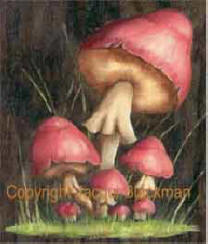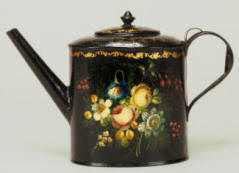 |
Tole and One-stroke Painting One-Stroke Brushes |
 |
 |
Tole and One-stroke Painting One-Stroke Brushes |
 |
 Leicester School of Art and Technology built 1870, now part of De Monfort University. I studied here for 3 years. Use this link or history of the main Schools of Art |
One-Stroke Brushes for Tole and Decorative Painting. One-stroke brushes were designed for the 'One-Stroke' painting technique taught in the Schools of Art of the 17 and 1800's. The schools taught one-stroke' painting for use in the pottery, wallpaper, furniture and tea-tray industry. |
 Tole Painted Mushroom |
The main brush manufactures have maintained a supply of this type of brush, these days they are not always suitable for use with oil paint. Some of the main requirements of these brushes were:- they were made from a hard wearing filament that was soft and flexible; they had a longer length of hair between the ferrule and tip; they also needed to hold the weight of the oil paint. The usual filament was Sable, ideal for Tole painting which is 'one-stroke' on tin or metal-ware. Image left is a Tole painted Mushroom on a black background using oil paint.
© Jacqui Blackman 1993 |
 Image above is part of a Chippendale Tea Tray from the 1850's Copyright Falkners |
Chippendale and Sheraton furniture first came into being in the 1750's, usually found with decoration and gilding by the 1850's. Chippendale Tea Tray were highly decorated and gilded, popular into late Victorian times.
The one-stroke brush technique is easily distinguishable in the fine, existing examples, many in museums. They were painted with oil paint and fine haired brushes, gilded with both metal powder and leaf and highly varnished. Oil paint has been used for traditional and contemporary painting in many forms of art, not just for painting pictures on canvas. |
 Copyright Falkners |
Brushes are an important tool for expressing skill. Therefore it pays to buy the best available for the media and technique you are using. One-stroke brushes tend to have a longer length of filament between the ferrule and the tip, this facilitate the loading of the brush. The ruination of any brush is paint in the ferrule. The dried paint forces the filaments apart, this in turn prevents the brush coming back to it's normal shape, be it round or flat. (see brush cleaning) The longer length allows for greater carrying capacity when loading the brush, without the paint penetrating the ferrule. It also offers greater flexibility when applying the paint. Image left is a Tole Kettle or Watering Can 1840's |